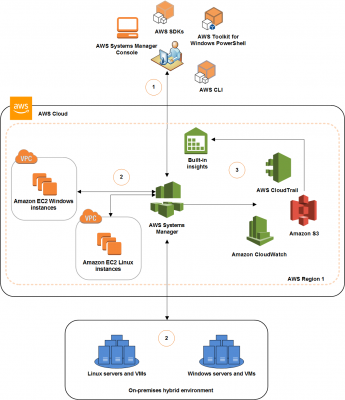- An interface for managing AWS resources
- Used for patch management for EC2s
- Used to categorize AWS resources
- view operational data from multiple AWS services
- automate operational tasks across AWS resources
- scans managed instances and reports any policy violations
- associate AWS resources by resource tag
- comprised of individual capabilities
- capabilities are grouped into categories
- Operations Management – manage AWS resources by CloudWatch Dashboards, OpsCenter, Resource Groups, Trusted Advisor and Personal Health Dashboard (PHD)
- Actions and Change – used for Automation and Maintenance
- Instances and Nodes – for EC2, provides Configuration, Compliance, Inventory Management, State Management, Patch Management
- Shared Resources – involves Systems Manager Documents (SSM), Parameter Store (for configuration data)
Working

- Configure Systems Manager: Use the Systems Manager console, SDK, AWS CLI, or AWS Tools for Windows PowerShell to configure, schedule, automate, and run actions that you want to perform on your AWS resources.
- Verification and processing: Systems Manager verifies the configurations, including permissions, and sends requests to the SSM Agent running on your instances or servers in your hybrid environment. SSM Agent performs the specified configuration changes.
- Reporting: SSM Agent reports the status of the configuration changes and actions to Systems Manager in the AWS cloud. Systems Manager then sends the status to the user and various AWS services, if configured.
SSM Agent
- is Amazon software
- installed and configured on
- Amazon EC2 instance
- on-premises server
- a virtual machine (VM).
- Enables Systems Manager to update, manage, and configure these resources.
- The agent processes requests from Systems Manager service in AWS, and runs them as specified in request.
- sends status and execution information back to the Systems Manager service
- must be installed on each instance to use with Systems Manager.
- is preinstalled, by default, on instances
created from following AMIs
- Windows Server 2003-2012 R2 AMIs published in November 2016 or later
- Windows Server 2016 and 2019
- Amazon Linux
- Amazon Linux 2
- Ubuntu Server 16.04
- Ubuntu Server 18.04
- Work with Systems Manager by
- Systems Manager Console – browser-based interface
- AWS Command Line Tools
- AWS SDKs
